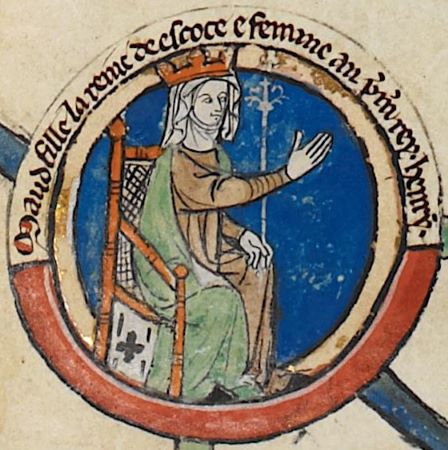In the Anglo-Saxon Chronicle there is a terse passage dealing with an important event which happened after Henry 1st claimed the throne.
It simply reads:
“And then soon after this the king took as his wife Maud (i.e. Matilda) daughter of King Malcolm of Scotland and the good Queen Margaret, King Edward’s relative of the rightful royal family of England.”
In these few words we can clearly pick up the partisanship of the monk who wrote it. First ‘good’ Queen Margaret indicates that the writing monk is aware of her famous piety. Indeed she was widely praised by clerical opinion, was the subject of a hagiographic account of her life and later became a Saint. Not only that, she was of the true English bloodline and thus belonged to the‘rightful’ royal family of England. This writer is in no doubt that she has strong justification to be Queen of England, with perhaps more right to the throne even than her husband, Henry.
It is from these little touches that we get a flavour of the preferences and partisanships of the individual monks and the monastic houses where they are writing. Certainly the Peterborough Manuscript is well and truly in favour of Matilda as a proper and fitting wife for the king; someone whose lineage could even boost the king’s own standing in England and seal the legitmacy of his reign.

“And on the Feast of St Martin, (11th November) she was given to him in Westminster with great honour and the Archbishop Anselm married her to him and afterwards consecrated her queen.”
What the recording monk doesn’t say, and probably did not know, is that Archbishop Anselm, would not agree to the marriage service between Matilda and her king without first conducting an inquiry into her past life. The question that Anselm needed to answer was: had Matilda ever been a nun? If she had, if she had taken vows or worn the veil, was she eligible to marry anybody, let alone the king?
So, before she could become Queen, Matilda had to undergo a form of trial, an inquiry into her past life to establish whether she had ever been a nun at Wilton. It was something that Archbishop Anselm needed to investigate. And here we get an insight into the power of churchmen at that time. If Anselm should refuse to marry Matilda to Henry he would be obstructing a declared wish of the King. You might ask – why didn’t Henry just get another churchman to do the service? The truth is Henry needed Anselm. He needed Anselm’s support at that time when his new reign was shaky. He needed the support of the Archbishop of Canterbury, who was the premier cleric in the country, to seal the legitimacy of his claim to the throne. In other words the King couldn’t always do what he wanted. He had to comply.
So, sometime between Michaelmas (Sept 29th) and St Martin’s Day (Nov 11th), this momentous inquiry was convened at Lambeth Palace where a panel of the highest clergy proceeded to examine the facts of Matilda’s past. She had been no more than a child at the time, subject to the will and control of others, especially Aunt Christina who, a nun herself, was said to have pressurised Matilda into taking the veil.
Matilda was summoned to the inquiry and was present in person. She, a young woman desperate to take aim at power, was forced to listen as doubts were cast on her past life, her child’s life, by a gathering of elderly men.The whole thing was in nature very like a trial.
Had Matilda worn the veil? Had she taken vows? Had she been dedicated to a spiritual life?
Luckily for us, as well as the Anglo-Saxon Chronicle, we have a much more detailed record of this inquiry written by Eadmer in Historia Novorum in Anglia.
One of the reasons Eadmer wants to write about this episode is to defend Anselm. He writes:
“I am particularly anxious to do this because quite a large number of people have maligned Anselm saying, as we ourselves have heard them do, that in this matter he did not keep to the path of strict right.”
(Translated by Geoffrey Bosanquet, The Cresset Press, London, 1964, p. 127)
So Eadmer is not unbiassed any more than the Peterborough monk.
But at least Eadmer himself was present at the inquiry and was thus able to give a first hand account of the proceedings. He even reconstructs some of the questions and answers in detail. This is an immensely dramatic moment, not only in the individual lives of the people involved, but because it would have consequences for the course of English history. Also Eadmer’s eyewitness account gives us a remarkable insight into the personality of the young Matilda and her astonishing performance at the inquiry. Far from being silenced by the prospect of disapproval and condemnation, she got up and defended herself in no uncertain terms.
What would be the finding of the inquiry? What would be the judgement of Anselm? Matilda’s future hung on this decision.
You can read an insider’s account of this dramatic episode in After the Arrow, Chapter Three.